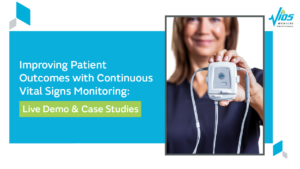
What Vios Has Learned About the Importance of Monitoring Patients Vital Signs During a Health Crisis
Not only has COVID-19 taught us new lessons, but it has also re-confirmed many long-held ideas regarding patient care and physiologic monitoring systems. These valuable lessons learned can help us be prepared in the future when the next local, regional, national or global health crisis occurs.
That’s why the team at Vios is taking the time to document these lessons today. So now and in the future, we are better prepared to provide patients with the best care possible.
Patient Vital Sign Monitoring Always Matters
A patient’s vital signs are exactly that: vital. That’s why we created the Vios Monitoring System.
The Vios Monitoring System (VMS) is a wireless, FDA-cleared, internet of things (IoT) patient monitoring solution designed to improve patient outcomes and reduce costs. The VMS enables clinicians to continuously monitor a patient’s 7-lead ECG, heart rate, respiratory rate, pulse rate, SpO2 and posture. It also accommodates the manual entry and input of blood pressure and body temperature data. Healthcare facilities are able to leverage their existing IT infrastructures and deploy the solution throughout their various care settings.
Why do vital sign monitoring systems matter during a health crisis? Because they are the first line of patient data and a strong indicator of health. Even minor shifts in the numbers can indicate a significant change in a patient’s status. This is particularly true during a viral pandemic such as COVID-19. While tests were in short supply or access limited, clinicians and doctors needed to track the vital signs to assess the possibility of viral infection as well as a patient’s status.
All of this makes continuous vital sign monitoring of the utmost importance. With this data, clinicians and doctors can detect changes the moment they happen. With this information, they can take steps to mediate the situation if possible. In some cases, this early identification and action can decrease the severity of the situation. This can greatly impact the need to send a patient to a higher acuity setting, thus minimizing strain in that unit.
Continuous Vital Sign Monitoring Without Continuous Contact
During a health crisis, clinician responsibilities are often multiplied. Everything, including staff capacity, is strained.
Plus, in the name of patient and staff safety, efforts are made to limit one-to-one contact or unnecessary interactions. In fact, in addition to the use of personal protective equipment, the Centers for Disease Control and Prevention (CDC) has recommended avoiding close contact to limit the spread of COVID-19.
Using the Vios Monitoring System, clinicians are supported in their work and able to follow CDC recommendations. The VMS keeps clinicians abreast of a patient’s vital signs allowing them to provide superior care without having to unnecessarily enter the room. That’s because clinicians are able to observe a patient’s vitals using the remote monitoring station, or via a mobile tablet. It links wirelessly to the Vios wearable vital signs monitor.
When clinicians do enter a patient’s room, the interactions are purposeful and necessary to the care program.
What’s more, the VMS can be used in combination with the Vios Remote Monitoring Service (RMS). This is an offsite monitoring service staffed and supported by VIOS, that makes it possible for patient data to be continuously monitored in any hospital environment. RMS supports your staff by providing around the clock monitoring or alerts, alarms and status changes.
Using this combination of tools and services, the Vios Monitoring System ensures patients are always being observed while also minimizing direct contact or in-room check-ins.
Addressing Many Crisis Needs
Nothing about a crisis is normal. The demands are greater, the protocols stricter and the strain on technological resources increased. Because the Vios Monitoring System is highly scalable and incredibly flexible, it is viewed as a highly advantageous asset with numerous benefits, especially during a health crisis.
Scalable
Expanding the number of chest monitors in use is an easy process. This allows healthcare facilities to quickly ramp up monitoring capability to meet patient needs.
Flexible
Moving patients and monitoring systems from room to room can be challenging. Since the Vios Monitoring System relies on WiFi, it’s simple to move patients, reallocate beds or even reassign units to meet the needs of a health crisis. This is called flex capacity and it opens up options with how you use the facility’s spaces and resources.
Powerful Lessons for Better Patient Care
A pandemic like COVID-19 has pushed many clinicians within a hospital setting to the edge of their capabilities. In some cases, even beyond the edge. However, from these challenges came lessons.
If we learn from them and adapt our processes, we can be better prepared when a health crisis strikes again. And, perhaps, even help alleviate the strain of this current situation.
There is no telling how long things will continue as they are. No one can say if a second or a third wave is coming. But we can be prepared, we can improve and we can take the step available to improve patient vital signs monitoring, care and staff workload. Connect with Vios and find out how your facility can be better positioned to handle a health crisis.
We’re ready to help improve patient care and support clinical staff.



